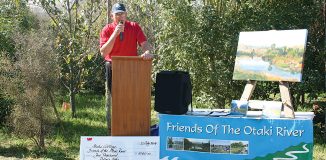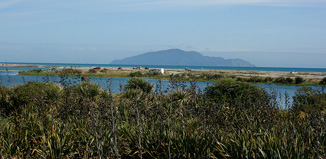On a sunny spring day a record 150 people took part in the recent annual Otaki River walkover, to view the ongoing flood protection and environmental works.
“I saw up the river a few months ago and things have already changed,” Kapiti mayor, Ross Church said at the end of the day. “I love the idea that things are new and finished but it’s an ongoing project. It’s fantastic, the enthusiasm and number of volunteers working here and the number of people looking at the ongoing projects.”
The walkover is organised by the Greater Wellington Regional Council flood protection department in conjunction with the Friends of the Otaki River environmental group. (FOTOR)
“The walkover is part of our partnership with the Friends of the Otaki River,” said Barbara Donaldson, chair GW environmental committee. “We thank and acknowledge the Friends, who do an enormous job on the river.”
Travelling in three buses, they visited sites from the upper Rahui down to the estuary, viewing some of the erosion along the south bank and newly installed means of protection. There were opportunities to see the newly planted areas, completed by the Friends volunteers and flood protection work which the Otaki depot has carried out over the last 12 months.
With no major floods in the last eight to nine years, much of the protection work carried out has been sustained.
Thirty per cent of the flood protection work is channel management and the realignment of the Upper Rahui is a major part of that work, keeping the main flow from the south bank and using willow for protection and enhancement to help protect the cliffs. The use of vegetation – particularly willows, is used until gravel can be extracted and work on deepening of the central channel is done. When a flood goes through, the willows slow down the flow and the silt carried drops down to the ground and helps regenerate new growth.
The flood protection staff will be doing a lot of willow planting over the next year – willow because they can cut “staffs” for planting as well as using it for layering. The natural pests, willow sawfly and willow aphid have given the trees a “beating” over recent years, eating all the leaves and affecting the root structure and making the trees insecure.
Down river towards the Chrystalls Bend, new rock lines, rock groynes and debris fences have been installed along the south bank. Each rock groyne holds 600 tonnes of rock, enclosed in heavy netting, with a debris fence between every two groynes. The debris fence is constructed of waratahs and three to four lines of cable installed out into the river, which trap trees and other debris during a flood. This helps build up the bank, too.
There are currently seven rock groynes along the south bank, west of Chrystalls Bend. Kaas Nauta, Otaki project engineer for flood protection, said. “We did have to divert the river to the north bank during work, but it’s starting to move back of its own accord already.”

They will continue using willows and rocks, but in the long term they will be replaced with natives.
During morning tea at Chrystalls Lagoon, provided by GWRC, a painting of the lagoon, painted and donated by Levin artist Grace Goss, was auctioned on behalf of the Friends. After some spirited bidding the painting sold for over $800 to a member of the Friends.
“This is a day for the community. I acknowledge the volunteers who usually work on Wednesdays!” FOTOR president, Max Lutz said. “The job of FOTOR is to monitor work on the river, your job (GWRC) is to take them out for a special time one day a year to see what we did last year and what’s coming up!”
After viewing the Honda plantings and rock groynes on the Tracey’s south banks, west of Chrystalls Bend, the next stop was at the Otaki Lakes behind the Stresscrete site.
Currently Winstone Aggregates is using a drag line to extract gravel from the bottom of the lake, the four cubic metre bucket can remove 300 tonnes of gravel per hour. The western end of the lake is two metres deep, but at the centre where they are working the drag line, it is eight metres deep going down to 10 metres, over the next couple of years. The completed lake will be 8-10 metres deep. The lake could be completed within two years, with the extra gravel being used for the McKays to Peka Peka expressway now, and later the Peka Peka to Otaki section as well as Transmission Gully work over the next six years or so.

Winstone also has a contract with GWRC to remove 53,000 cubic metres of gravel from the river, to assist with channel control. About $530,000 is spent on river maintenance a year.
“This is keeping us going with the expressway construction,” Winstone Otaki manager, Shane Hagai said. “We use all the material we extract, with very little waste. We crush most of the gravel.”
A stopover at the site for the new twin bridges for the northern expressway was the next port of call. New Zealand Transport Agency’s Rowan Oliver was present to speak of the planned bridges and their concern and care for the native banded dotterel which nest in the area.
“The twin bridges will be 120 metres upriver from the rail bridge. We will make sure our bridge will not affect the flood flow,” he said. The width of the river channel is only 140 m at the current bridges, reduced from 250 metre channel at the Upper Rahui.
West of the highway bridges, the party saw the use of rock groynes and stopbank on the southern banks to protect from erosion and a 20 year flood level. Most of the northbank work would involve weed eradication and lowering the current stopbank, which is considerably higher than required for a100 year flood.
The final stop, before lunch at the Otaki Works Depot, was at the river estuary and flood gates, where again people could view the environmental work the Friends have been doing, the waste land clearance and wetland planting in progress.
“It’s been a very good day, very successful,” Mr Lutz said. “There were lots of new people, a good representation from Greater Wellington and KCDC and we’re building a relationship with NZTA and working to maintain the walkway.”
Among those on the bus trip were representatives from Greater Wellington council representatives and staff, KCDC councillors and staff and members of the Otaki Community Board.

